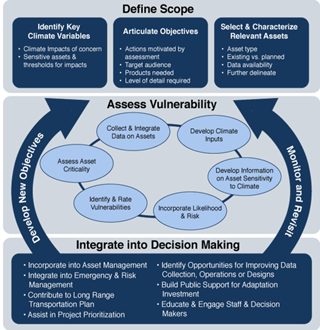Infrastructure resilience has become an important topic for North Carolina. Recent hurricanes and other extreme events have caused more than $450 million in direct damage to the State’s transportation infrastructure and innumerable indirect damage from losses in mobility, additional travel times needed while repairs were made, and other impacts.
Though the North Carolina DOT (NCDOT) has been conducting studies to understand vulnerability and risk to its assets, most of these have focused on hydraulic structures and/or pavements that were located on top of, or adjacent to, hydraulic structures. However, during Hurricane Florence there were more than 2,730 pavement sites that were damaged where hydraulic structures were not involved (74% of all categorized damage sites in the Survey 123 system).
To improve the resilience of these pavements, it is important to conduct an engineering informed assessment, which requires a detailed understanding of the particular design features and the variation thereof inherent to the infrastructure element or system in question and pathways by which that infrastructure can fail.

Schematic of FHWA’s VAST framework (Filosa et al.
2017).
In light of these issues, the proposed research plan will seek to achieve five objectives. 1) Provide a better understanding of the failure pathways and factors contributing to pavement failures during past events. 2) Identify the gaps and critical data linkages that hinder the use of existing NCDOT information to support resilience-based planning with respect to pavements. 3) Develop a framework for identifying and prioritizing road segments as part of resilience-based improvement plans/programs. 4) Develop a design feature selection and repair strategy decision tree that considers specific features, planned needs, sustainability considerations, and possible extreme event stressors at a given pavement site. 5) Identify data gaps and critical data linkages that hinder the use of existing NCDOT information to support this effort and provide recommendations to improve data collection and information to support resiliency efforts.
These objectives will be met with four tasks:
1. The relevant literature that describes studies on resilience (in general) and pavements (specifically) will be reviewed. This review will supplement and not duplicate the efforts of other ongoing and completed studies.
2. Identify the defining characteristics that affect pavement vulnerability. This assessment will be comprehensive and cover (insomuch as currently published data allows) assessment of flexible, rigid, and composite pavements.
3. Development of a decision analysis framework for assessment and adaption of specific projects, but also for use in long-term planning to identify particularly vulnerable regions.
4. A final report summarizing the methodology, results, and recommendations will be prepared.
The primary outcome of the proposed research will be a design feature selection and repair strategy decision tree that considers specific features, planned needs, sustainability considerations, and possible stressors at a given pavement site. Another product will be identification of critical data linkages that hinder the use of existing NCDOT information to support this effort and recommendations to improve data collection and information to support resilience efforts. This research will provide NCDOT personnel with the tools necessary to take a proactive approach to inform pavement resilience project identification and prioritization based upon the as-built and current condition of roadway segments.
